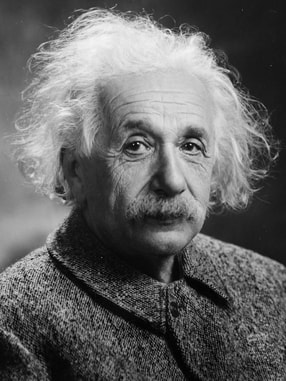 Albert Einstein Albert Einstein When it comes to scientists, one of the most recognized names in our world is that of Albert Einstein. Einstein, who won the Nobel Prize in Physics in 1921, is the creator of the theory of relativity which led to the prediction of amazing things such as deflection of light by gravity, gravitational lensing, black holes, gravitational waves, and the expanding universe, all of which have all been proven by many observations and experiments. Einstein ushered in a revolution in physics. He clearly was a genius, but in some aspects the way his mind worked was no different from that of any average human being. Deflection of Light Both Newton’s theory of gravitation and Einstein’s theory of relativity predicted that light would be deflected by a strong gravitational field, but Einstein’s theory predicted that light would be deflected by an amount roughly double of that predicted by Newton’s theory. In 1919 during a solar eclipse, it was observed that indeed light from stars close to the sun was deflected by an amount compatible with Einstein’s theory. This result, which made Einstein a worldwide sensation, has been verified with increasing accuracy many times since then. But what is less well known is that Einstein had originally made a calculation error which led him to find a deflection value no different from that predicted by Newton’s theory. This meant that the observation of the deflection of the light of stars by the sun would have disagreed with both theories. Thankfully, by the time the observation was made, Einstein had corrected his mistake, and the actual magnitude of the deflection agreed with his theory. Gravitational Lensing Einstein had figured out that, according to his theory of relativity, the strong magnetic field of a star could act as a lens and amplify the light of other distant stars behind it. But he realized the effect would be very small and fleeting, so did not deem it worthwhile publishing anything about it. However, in 1936 an amateur scientist named Rudi W. Mandl also figured out that this was one of the consequences of Einstein’s theory. He contacted Einstein who agreed the effect was indeed predicted by his theory and, after some pestering, consented to write an article about it. Einstein wrote the article acknowledging Mandl’s contribution, but stated in it that there is no chance of observing this phenomenon. At the time Einstein wrote this, he was thinking in terms of stars because the realization that there were distinct galaxies beyond our own was relatively new, and astronomers had not yet understood the real vastness of the universe. But astronomers eventually figured out that entire galaxies could act as gravitational lenses, and the first example of such a lens was discovered in 1979. Black Holes Another consequence of the theory of general relativity was the possibility of the existence of black holes, but Einstein was also dismissive of these entities, and he published an article in 1939 using his own theory to argue that black holes did not exist. In the decades after Einstein’s death in 1955, the evidence for the existence of black holes accrued until 2019 when a black hole was photographed for the first time. Gravitational Waves Einstein’s theory of relativity included the possibility of the existence of gravitational waves, but he confided to some colleagues that he was skeptical about their existence or the possibility that they would ever be detected. He followed this by another article where he specifically examined the math behind such waves, but in this article, as was pointed out to him by other scientists, he made a calculation error. Two years later, he published another article where he corrected his previous error and finally laid down the correct mathematical framework for describing gravitational waves. However, Einstein remained skeptical about the reality of such waves. Two decades later, in 1936, Einstein revisited the issue of gravitational waves in another article where he argued that the math really did not favor of the existence of such waves after all. He sent this article for publication in a science magazine, but the magazine sent the article to a reviewer who found a mistake in Einstein’s calculations. When Einstein redid the calculations, he found that the math did support the existence of gravitational waves after all! Still, the whole notion of the existence of gravitational waves was too outrageous for Einstein to accept. Untill the day of his death, he remained skeptical that these waves were anything but a mathematical construct, and even if they were real, he thought that they would be so faint that it would be impossible to detect them. The first gravitational waves were detected in 2015. Expansion of the Universe In 1917, Einstein wrote an article where he used his theory of general relativity to examine the universe. To his surprise, he found that the math indicated that the universe would expand forever. However, astronomical knowledge at the time indicated that the universe was supposed to be unchanging, so Einstein came up with a mathematical solution. He included a “cosmological constant” in the calculations, which prevented the universe from expanding forever. Other scientists challenged Einstein on this notion to the point that he conceded his original math without the constant was right, but he still doubted the reality of his conclusions. It was only after Edwin Hubble demonstrated in 1929 that the universe is indeed expanding that the prediction of Einstein’s theory were found to be right. The above reveals how one of the greatest minds that humanity has ever seen worked. Einstein made mistakes. He was unsure about the implications of his theory. He changed his mind several times. He doubted or dismissed the existence of some of the very things that he is credited with predicting, and he sometimes even lacked the vision to imagine future realities. This is how real science works and what real scientists are like. Science is messy. Scientists screw up. They vacillate, they change their minds, and sometimes they are unable to grasp the real consequences of the very things they propose. This IS normal, and is something that happens to everyone. But in the current poisoned climate where scientists on the “wrong” side of the culture wars are attacked for making mistakes, flip-flopping, or saying the wrong thing during an interview and so forth, one wonders if, for example, the discoveries that Einstein made would have been possible if he had been subjected to the scrutiny and slander that some scientists are subjected to nowadays. The photograph of Albert Einstein by Orren Jack Turner obtained from the Library of Congress is in the public domain because it was published in the United States between 1923 and 1963 and the copyright was not renewed.
0 Comments
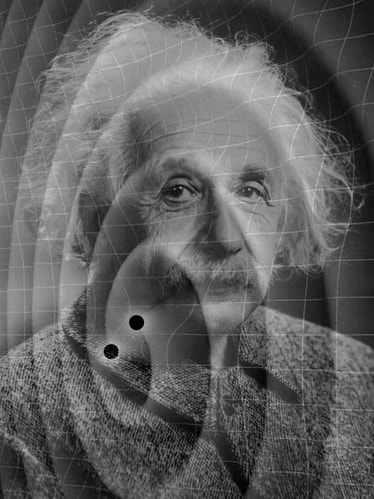 Einstein and Gravitational Waves Einstein and Gravitational Waves So far, the greatest achievement of physics in this century is the detection of gravitational waves. These are ripples in the fabric of spacetime created in titanic explosions millions to billions of light years away, such as the merger of black holes or the collision of neutron stars. The arrays of massive equipment that were used to detect the waves as well as improved versions under construction, will allow us to look at the universe in a new way and usher in an exciting era of space exploration. The detection of these waves represents the culmination of decades of arguments, counterarguments, mistakes, dead ends, and failed attempts at conceptualizing and detecting the waves by some of the greatest minds to have walked the planet. Chief among them was Albert Einstein. And Einstein’s story, as most scientific stories are, is complicated. While others had considered and argued for gravitational waves, it was Einstein who formally laid the mathematical foundation for the existence of these waves with his 1916 article on General Relativity. However, the math was fiendishly complex and dependent on systems or coordinates that had to be chosen carefully. The conclusion that the waves existed was not straightforward, and was dependent on how you approached the calculations. Einstein himself was skeptical about the reality of the waves, and made it clear in letters sent to colleagues. Einstein and the scientist Nathan Rosen revisited the existence of gravitational waves again in 1936. After doing the elaborate math, they came up with an explanation of why the waves could not exist, and they submitted their research for publication in a leading physics journal, The Physical Review. The journal sent the article to an anonymous reviewer who found a mistake in Einstein’s calculations, and the article was not accepted. This greatly annoyed Einstein, as he had not authorized the journal to show his work to an independent reviewer, and he submitted the article to another journal which accepted it for publication.
On the meantime, the independent reviewer, the physicist Howard Robertson, managed to contact Einstein. By then Einstein had taken another look at his article and figured out there was something wrong with it. Without telling him that he was the reviewer, Robertson suggested to Einstein the right approach to perform the calculations. So Einstein redid the calculations and came to the opposite conclusion. Gravitational waves existed after all! He contacted the journal to prevent the publication of the article with the old conclusion, he rewrote the article, and finally published it with the new conclusion in 1937. However, until his death in 1955 Einstein remained ambivalent about the reality of these waves, and whether they could even be detected if they indeed were real. His coauthor in the 1937 article, Nathan Rosen, was also skeptical regarding whether gravitational waves were more than a mathematical construct, and he published articles arguing against them using controversial mathematical procedures. In the late 1950s, several scientists built upon Einstein’s work and developed the mathematical approaches that firmly established the theoretical rationale for the existence of gravitational waves within the framework of Einstein’s theory of relativity. It would be 60 years after Einstein’s death before gravitational waves were finally detected. The story behind gravitational waves is a success story of science and perseverance by generations of scientists with Einstein playing a central role. However, I wondered what would have happened if the research into gravitational waves had become politicized in the age of social media after, for example, a heavy-weight political personality publicly balked at the price tag of proposed gravitational wave detectors and labelled the science “fake science”. I imagine some of the resulting messages in social media may have looked something like this: As it turns out the “genius” published in favor of #gravitationalwaves but in private argued against them! #Einsteinhypocrite He was honestly for them, then honestly against them, and then honestly for them again? Yeah, right! #Einsteinflipflop Why did a leading physics journal reject Einstein’s article against gravitational waves, and then a reviewer for the same journal secretly influenced Einstein to change his calculations and his conclusions? #ThePhysicalReviewgate #gravitationalwavescandal #Einsteinfraud sold out to the scientific establishment that wants to milk the taxpayers for their hard-earned money to finance fake projects! #gravitationalwavehoax Einstein and Rosen didn’t think gravitational waves would ever be detected, but now physicists are asking for billions to do just that. #fakescience Any money for the #gravitationalwavescam is money that is not used to save lives and help ordinary Americans. Stop feeding the bureaucratic beast with #fakeprojects! Stop killing American Citizens! You get the idea? Now imagine doing science under this environment. If you publish anything “for” or “against” gravitational waves and are vocal about it, thousands of people may roast you in social media. Your past activities and statements will be scrutinized with a fine-tooth comb to find something that can be used against you. Any mistake you may have made, any publication you may have retracted, any change of opinion you may have had, may be incorporated into memes containing misleading or false statements about you that may go viral all over the planet. Someone may figure out your e-mail and phone numbers and make them available online. Dozens of people may contact you leaving insulting or threatening messages. Depending on your visibility, you may have to get or be assigned a bodyguard. Would gravitational waves ever have been detected if gravitational wave research had been politicized in this fashion? The above scenario illustrates how you can take hold of the often complex and messy reality of human beings doing science (or any other activity for that matter) and twist it to argue in favor of nefarious purposes smearing the reputation of those involved and creating stress and anxiety for many people who don’t need it. Even though the specific scenario I presented concerning gravitational waves is fictitious, similar things are currently happening in the fields of climate change, vaccine science, and the research into the effectiveness of hydroxychloroquine and other drugs against COVID-19. Do not politicize the science! The photograph of Albert Einstein by Orren Jack Turner obtained from the Library of Congress, and an artist’s rendition of gravitational waves from NASA, are both in the public domain and were merged and modified. 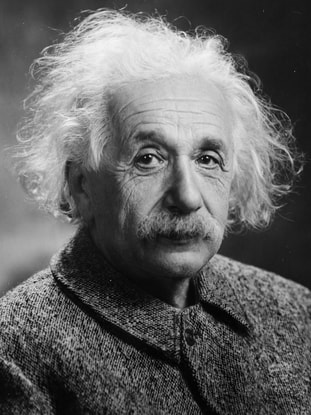 Albert Einstein Albert Einstein When many people think of scientists, images such as that of Einstein come to mind. Einstein and other scientists in his league asked important questions regarding the nature of reality in order to discover its underlying principles. However, individuals like Einstein are the exception rather than the rule with regards to what most scientist do. The majority of scientists are involved in the application of science to answer very specific and practical questions. Is this drug safe? Is this water sample polluted? What illness does this patient have? Did this gun fire this bullet? These are all questions that are not likely to get you a Nobel Prize anytime soon, but their answer is of vital importance to our society. In fact, many scientists are involved in professions that do not necessarily even require the performance of experiments on a regular basis or at all. Additionally, science has become such a fiendishly complicated enterprise that many individuals that do not intend to become hard core scientists nevertheless need to study and train for many years even up to the Ph.D. or postdoctoral level to acquire an acceptable degree of mastery in the subject. This post is about these other scientists. Doctors: Although all doctors are trained to be scientists, not all perform research. From general practitioners to specialists, many doctors set up or join private practices and dedicate themselves exclusively to servicing their patients, thus fulfilling an important function in society. Quality Control Scientists: The job of quality control scientists is to test each batch of a manufactured product to make sure it conforms to established parameters. In quality control, the procedures used to test new batches of products must the performed in the same way, day after day, month after month, and year after year. Data and procedures have to be meticulously recorded. Equipment and assays have to be fine-tuned and calibrated. The lives of people and millions of dollars in company resources depend on quality control scientist doing their job right. Forensic Scientists Forensic scientists apply the methods of science to analyze physical and chemical evidence to solve crimes. From fingerprinting, entomology, and botany, to toxicology, pathology, and DNA analysis, many disciplines of science converge to help in fighting crime and evaluating the culpability of suspects. Scientific Reviewers: Every year there are billions of dollars in public and private funds allocated for research, and there are thousands of research proposals that request these funds. How do funding agencies decide which proposals to fund? Here is where a type of scientist known as a scientific reviewer comes in. Scientific reviewers organize and conduct meetings with scientists, who are experts in their field, to review and score grant proposals. These scientists play an invaluable role in the process of allocating millions of dollars in public and private funds for research. Patent Attorneys: Individuals and corporations want to protect their discoveries by writing patent applications to the government or defend their patents in court when they have been infringed. Patent attorneys are involved in the process of writing patents and in disputes over patent rights. Some scientists, after obtaining their degree in science, choose to pursue a law degree to become patent attorneys. The scientific background allows them to understand the complexity and nuances of the subject matter they encounter, and to argue cases to juries and judges. Patent Examiners: Hundreds of thousands of claims are made every year to the government requesting that new inventions and procedures be protected by the awarding of a patent. The type of protection afforded by a patent is vital for the viability of many industries. But how is the government to know which patent request should be approved? This is the job of patent examiners. Patent examiners are scientists who search the available scientific literature and related databases to evaluate which claims should receive patent protection. Regulatory Scientists: The process by which scientific discoveries result in practical applications involves following many rules at the municipal, state, and federal levels and requires a lot of oversight by regulatory agencies. There are tens of thousands of regulatory scientists involved in making sure that scientific products such as drugs or medical devices are effective and that they are produced in a safe manner. Science Writers: Another important and versatile scientific activity is science writing. There are scientists who write the technical specifications of products made by companies. Others are involved in writing up the presentation of the company’s products to consumers. Some scientists write applications for the approval of products by regulatory agencies, while other scientists edit articles to be published in science journals. Still other scientists are involved with writing grants or writing for publications or broadcast outlets that inform the public about the latest scientific discoveries or controversies. Teachers: As science becomes more complex, teachers are obtaining advanced degrees or training in science, and scientists are obtaining teaching degrees to be teachers. In an age where science is having incremental impacts in our lives with each passing year, it is important to teach new generations about the ways of science. I could go on, but the foregoing gives you an idea regarding the breadth of the applications of science in our society and the diversity of its practitioners many of whom do not necessarily engage in the classical image of the scientist asking big questions, making Earth-shattering discoveries, and winning the Nobel Prize. Not everyone is an Einstein, and that’s OK. The photograph of Albert Einstein by Orren Jack Turner obtained from the Library of Congress is in the public domain because it was published in the United States between 1923 and 1963 and the copyright was not renewed. 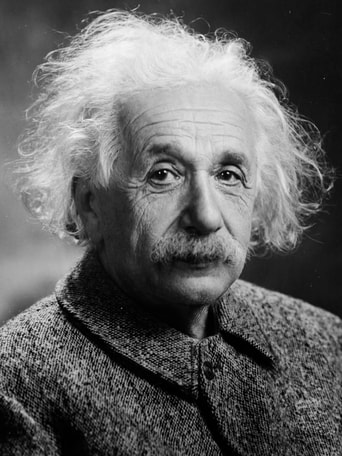 Albert Einstein Albert Einstein Albert Einstein was one of the towering figures of the twentieth century. Images of his face surrounded by a fluffy mat of white hair have become synonymous with genius in both popular and scientific cultural circles. Einstein’s contributions in many areas of physics range from the explanation of the photoelectric effect, the equivalence of energy and mass as defined in his famous E = MC2 equation, his reinterpretation of Newtonian mechanics (special theory of relativity), and his description of gravity as a property of space and time (general theory of relativity), to his work towards elucidating the nature of light, the existence of the atom, and the establishment of quantum mechanics. He predicted the existence of Bose-Einstein condensates, gravitational lensing, and gravitational waves, all of which have been confirmed. Einstein’s ideas resulted in practical applications in areas such as nuclear power, space travel, fiber optics, GPS, and computers, but his thinking has also influenced disciplines as varied as philosophy, art, and literature. It is not an overstatement to assert that this individual changed the world. As we stand in awe admiring Einstein’s accomplishments, we wonder where all that came from. Ideas, inspiration, and creativity are attributes that we associate with one organ in the body: the brain. Therefore, if Einstein was able to think all of these things up, but most other human beings are incapable of such feats, it follows that there must be something special about Einstein’s brain: something that differentiates it from the brain of common individuals, something that makes him vastly smarter. The reasoning then goes: if we find that something, that difference between Einstein’s brain and the brain of common folk, we will have found the nature of genius, the seat of intelligence. 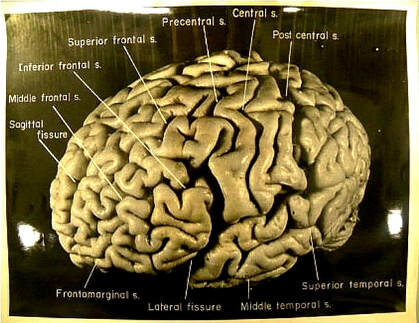 Einstein's Brain Einstein's Brain Einstein may have been curious about the above line of reasoning, but there is one thing we know for certain: he was aware of his fame, and he did not want to be idolized after his death. He left instructions that his body be cremated and his ashes scattered. However, when Einstein died in 1955, the temptation was too much for the Princeton Hospital pathologist that performed the autopsy; Thomas Harvey. Going against the wishes of Einstein’s family, Harvey removed Einstein’s brain. When the family found out, there was some acrimony, but Harvey managed to obtain permission from Einstein’s oldest son to keep the brain as long as it was used for scientific studies. When the hospital administrator found out what he did, Harvey was fired. He went on to practice medicine but eventually was not able to renew his medical license. His marriage ended in divorce, and he ended up working on the assembly line of a plastics factory to pay his bills. Harvey took pictures and measurements of Einstein’s brain, and he had parts of the brain sectioned into many pieces that were treated with dyes and sealed in slides. Over the span of decades, he tried to get scientists interested in looking at the brain, but found few takers. He sent slides to several eminent scientists, but they found nothing out of the ordinary. Eventually, a few scientists became interested enough to perform detailed studies of the morphology of the brain using the slides and photos of the intact brain that Harvey had taken, and some differences were found when comparing Einstein’s brain to those of regular people. However, whether these differences are related to Einstein’s intellectual prowess, or whether they are part of normal brain to brain variation that can be encountered among individuals, is still an open question. There is the possibility that genius is not correlated with an obvious gross morphological characteristic of brains, but rather to the more subtle ways in which its billions of neurons are interconnected. There is also the possibility that genius resides in the temporal and spatial pattern in which the neurons interact with each other. If this is the case, it is likely that nothing can be learned about genius from fixed dead brains, as only detailed imaging of living brains will reveal their secrets. Today, the physiological roots of intelligence and genius remain as elusive as ever. And perhaps that is a good thing. Since human beings began to study the brain, we have woven fanciful explanations as to the nature of intelligence. First brain size was the metric that was thought to be related to intelligence. Thus, when evidence was produced that some races had different brain sizes than others, this became the linchpin of ideas regarding the superiority and inferiority of these races. When the idea that brain size among normal human beings was correlated to intelligence fell into disrepute, we developed the idea that we could test for intelligence and reduce it to a number. Then soon enough evidence was generated that some races, or social classes, or groups of people, did better on intelligence tests than others, again leading to notions of superiority and inferiority. The eugenics movement arose in the early twentieth century advocating the betterment of the intellectual level of society. In the United States, terms like “feeble-minded” and “moron” were developed to denote people who scored poorly on intelligence tests. The eugenics craze in the United States led to restrictions on immigration and forced sterilizations of tens of thousands of people, which invariably affected to a greater extent those who were poor, uneducated, and from minority groups. All these terrible ideas are discredited nowadays, at least academically, but watered down versions of these ideas still linger among the general public and some scholars. Asking questions about what made Einstein extremely intelligent are legitimate. But my fear is that if we do discover some characteristic in the brain responsible for genius, let’s call it “X”, we will again travel down this well-worn step by step path: 1) “X” made Einstein a genius. 2) Therefore, the more of “X” you have, the more intelligent you are. 3) We can classify otherwise normal individuals into whether they are more or less intelligent based of the amount of “X” they have. 4) Groups of people displaying lower levels of “X” are dumber. 5) Groups of people displaying lower levels of “X” are inferior. 6) Allowing these groups of people with less “X” to breed or to come to our country will compromise our society. 7) We must do something about it. A while ago I did something that Einstein would have disapproved of. I went to the National Museum of Health and Medicine in Silver Spring, Maryland. As part of what they call “Brain Awareness Week” they had an exhibition on Einstein’s Brain. The museum has a set of slides made from Einstein’s brain that Harvey’s estate donated after Harvey died, and some of them were on exhibit. So I took a picture (see below). This section of Einstein’s brain was stained for myelin, the protein that ensheaths the axons of neurons. The black area is the fiber tracks (the white matter in the brain), and the brown area is where the neuronal cell bodies reside (grey matter). There is (or was) something in sections like these that made possible the thinking of ideas that no one had ever thought before, revolutionizing our view of reality, and changing our world forever. What is or was that something? And if we ever discover it, what will we do with that knowledge? The photograph of Albert Einstein by Orren Jack Turner obtained from the Library of Congress is in the public domain. The image of Einstein’s brain was cropped and modified from the article: Falk, Dean, Frederick E. Lepore, and Adrianne Noe. "The cerebral cortex of Albert Einstein: a description and preliminary analysis of unpublished photographs." Brain 136.4 (2012): 1304-1327, and is used here under a NonCommercial 3.0 Unported (CC BY-NC 3.0) license. The image of the section of Einstein’s brain is by the author and can only be used with permission. Some scientific theories that are in the way of religious, political, and corporate interests have been getting a bad rap. These theories are claimed to be false by their foes. So for example, creationist claim that evolution is false, climate change deniers claim that global warming is false, and so on. In fact, many people seem to imply that theories are ephemeral, and to buttress their claim they offer a list of theories that have been proven “false”. Why should we rely on a scientific theory to affect public policy today if it can be shown to be false tomorrow? In addressing this issue there are several things we have to consider. Before we begin, we need to make the clarification that the word “theory” in the popular parlance can be a synonym for a guess or a very preliminary explanation. In science, a theory is a vastly more stable form of knowledge. In fact, if the theory is sufficiently developed, it in itself can become a fact. So what are the characteristics of a sufficiently developed theory? They are: 1) It explains the existing observations and experimental results. 2) It has generated predictions that have been found to be true. 3) It has generated practical applications that work. 4) Results from other scientific disciplines corroborate the theory and the theory corroborates results in other scientific disciplines. Please read the list above again carefully. Don’t you think that when a theory fulfils these characteristics we can say with confidence that it has clearly grasped important aspects of the realities it’s trying to explain? But, you may ask, what if a genius like an Einstein comes along and thinks up a new interpretation for everything the theory explains and predicts, and expands it into a different theory to explain new things? Can’t we say then the theory was proven false? 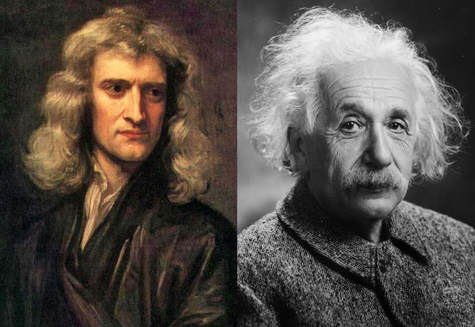 Well, let’s consider what Einstein did. He reinterpreted Newton’s laws of gravitation and motion, and came up with explanations for phenomena the Newtonian interpretations could not explain. Einstein thus relegated Newton’s laws to particular cases where velocities are much lower than that of the speed of light or when very strong gravitational fields are not involved. But here is the thing: the speeds at which planets, rockets, space probes, and objects in everyday life move, and their behavior in the gravitational fields that they encounter most of the time, can be described with a satisfactory level of accuracy by Newton’s laws. The existence of a planet (Neptune) and the return of a comet (Halley’s Comet) were predicted using Newton’s laws. The life of astronauts and the integrity of multimillion dollar space probes depend on the veracity of the calculations employing Newton’s Laws. Is it fair to say that Einstein proved Newton’s theories were false? Of course not! Einstein showed Newton’s theories were incomplete, and this is what the public has to understand when discussing scientific theories. Sufficiently developed scientific theories cannot be false, they can only be incomplete. When assessing scientific theories, it is counterproductive to talk in terms of true or false. What has to be discussed is whether a theory has been formulated at a high enough level of detail, in other words, whether the theory is complete enough. We don’t need theories to be 100% true. They can’t be (nothing can), and they don’t have to be. We only need the theory to be complete enough to be useful for society. Finally, it must be pointed out that the vast majority of scientific theories are not “big name” theories such as the theory of evolution or global warming. There are hundreds of scientific fields and subfields that have given rise to thousands of theories most of which are boring, highly technical, and devoid of importance to the “culture wars”. Therefore they do not make the news, and non-scientists are not even aware of them. Most of these theories have never been overturned, and in fact form the basis of modern science leading to tens of thousands of practical applications and policies. If these theories were not sufficiently complete representations of reality, modern life would not be possible! So next time you are pondering the worthiness of a scientific theory, remember, it's all in the completeness. The figure is a collage of a copy of a painting of Isaac Newton by Sir Godfrey Kneller (1689), which is in the public domain, and a photograph of Albert Einstein by Orren Jack Turner obtained from the Library of Congress, which is also in the public domain because it was published in the United States between 1923 and 1963 and the copyright was not renewed. |
Details
Categories
All
Archives
June 2024
|

 RSS Feed
RSS Feed